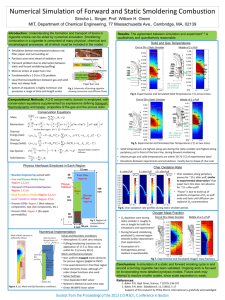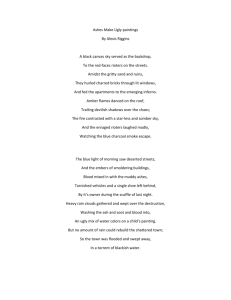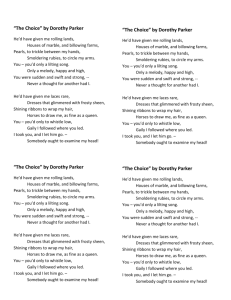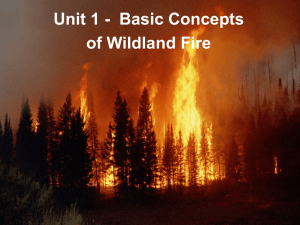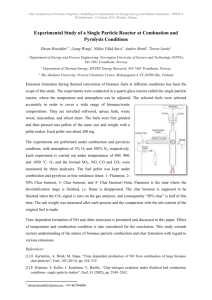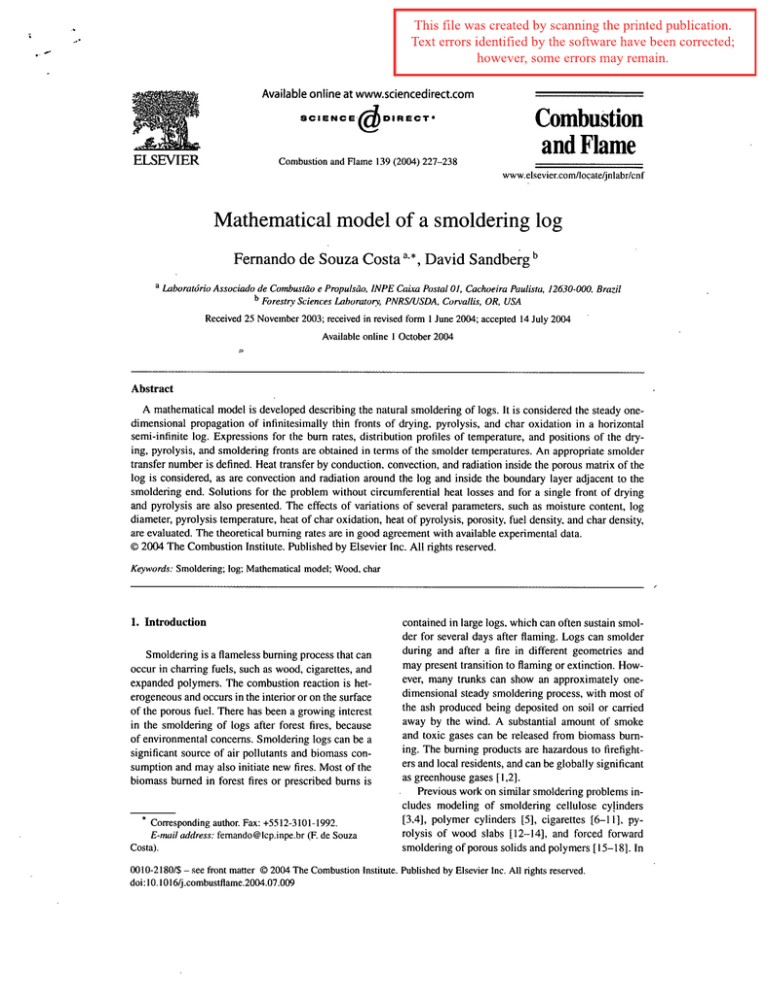
This file was created by scanning the printed publication.
Text errors identified by the software have been corrected;
however, some errors may remain.
~P
Available online at www.sciencedirect.com
SCIENCE ~ D I R E C T ~
ELSEVIER
Combustion and Flame 139 (2004) 227-238
Combustion
and Flame
www.elsevier.com/Iocate/jnlabr/cnf
Mathematical model of a smoldering log
Fernando de Souza Costa a.,, David Sandberg b
a Laboratdrio Associado de Combustgto e Propulsgto, INPE Caixa Postal 01, Cachoeira Paulista, 12630-000, Brazil
b Forestry Sciences Laborato~, PNRS/USDA, Corvallis, OR, USA
Received 25 November 2003; received in revised form 1 June 2004; accepted 14 July 2004
Available online 1 October 2004
Abstract
A mathematical model is developed describing the natural smoldering of logs. It is considered the steady onedimensional propagation of infinitesimally thin fronts of drying, pyrolysis, and char oxidation in a horizontal
semi-infinite log. Expressions for the burn rates, distribution profiles of temperature, and positions of the drying, pyrolysis, and smoldering fronts are obtained in terms of the smolder temperatures. An appropriate smolder
transfer number is defined. Heat transfer by conduction, convection, and radiation inside the porous matrix of the
log is considered, as are convection and radiation around the log and inside the boundary layer adjacent to the
smoldering end. Solutions for the problem without circumferential heat losses and for a single front of drying
and pyrolysis are also presented. The effects of variations of several parameters, such as moisture content, log
diameter, pyrolysis temperature, heat of char oxidation, heat of pyrolysis, porosity, fuel density, and char density,
are evaluated. The theoretical burning rates are in good agreement with available experimental data.
© 2004 The Combustion Institute. Published by Elsevier Inc. All rights reserved.
Keywords: Smoldering; log; Mathematical model; Wood, char
1. Introduction
Smoldering is a tameless burning process that can
occur in charring fuels, such as wood, cigarettes, and
expanded polymers. The combustion reaction is heterogeneous and occurs in the interior or on the surface
of the porous fuel. There has been a growing interest
in the smoldering of logs after forest fires, because
of environmental concerns. Smoldering logs can be a
significant source of air pollutants and biomass consumption and may also initiate new fires. Most of the
biomass burned in forest fires or prescribed burns is
* Corresponding author. Fax: +5512-3101-1992.
E-mail address: fernando@lcp.inpe.br (F. de Souza
Costa).
contained in large logs, which can often sustain smolder for several days after flaming. Logs can smolder
during and after a fire in different geometries and
may present transition to flaming or extinction. However, many trunks can show an approximately onedimensional steady smoldering process, with most of
the ash produced being deposited on soil or carried
away by the wind. A substantial amount of smoke
and toxic gases can be released from biomass burning. The burning products are hazardous to firefighters and local residents, and can be globally significant
as greenhouse gases [ 1,2].
Previous work on similar smoldering problems includes modeling of smoldering cellulose cy.linders
[3,4], polymer cylinders [5], cigarettes [6-11], pyrolysis of wood slabs [12-14], and forced forward
smoldering of porous solids and polymers [15-18]. In
0010-2180/$ - see front matter © 2004 The Combustion Institute. Published by Elsevier Inc. All fights reserved.
doi: 10.1016/j.combustttame.2004.07.009
b~
d
228
E de Souza Costa, D. Sandberg / Combustion and Flame 139 (2004) 227-238
Nomenclature
Ac
Bs
Cp,i
Cp.l
Cp.i
dp,i
hs
h0
h i.conv
hi,rad
fR
M
,h i'
• H
md
• I!
m c
m
• H
a
• i!
m w
rhtlV
Qco
an
aw
• #l
qw
0~'
• II
qconv
• #!
qrad
T
Tb
rp
Ts
adjustment factor
smoldering transfer number
specific heat of substance i = f, d, c, a,
w,v
specific heat of liquid water within the
wood
average specific heat of zone i = f, d, c
average pore diameter in zone i
heat convection coefficient around zone
i=f,d,c
convection heat transfer coefficient at
smoldering front
convection heat transfer coefficient without blowing
convective heat losses along zone i = f,
d, c
radiative losses along zone i = f, d, c
form factor for the smoldering surface
moisture, dry basis
mass consumption rate of virgin fuel
mass consumption rate of dry fuel
mass consumption rate of char
mass generation rate of ash
mass flow rate of water vapor
mass flow rate of volatiles
heat of char oxidation
heat of pyrolysis
heat of vaporization of water
heat flux to preheat and vaporize water
heat flux to pyrolyze dry fuel
heat flux at smoldering front
heat flux lost by convection
heat flux by radiation
temperature
vaporization temperature
pyrolysis temperature
smoldering temperature
general, the available solutions for natural or forced
smoldering problems are obtained by numerical integration of systems of differential equations or by
activation energy asymptotics.
An experimental investigation of smoldering in
biomass was made by Carvalho et al. [19] in a laboratory facility (forced smoldering) and in prescribed
forest burns (natural smoldering). They reported bum
rates varying from 0.09 to 0.4 mm/min and pointed
out that daytime rates were up to five times larger
than nighttime rates due to higher ambient temperatures, higher wind speeds, and lower relative humidity. Carvalho [20] performed additional experiments
Ta, i
Tmax.i
TO
T~
U
xd
Xs
YO2.~
YO2,s
average temperatures at zone i = f, d, c
maximum temperature in zone i
initial temperature
ambient temperature
smoldering rate
drying front position
smoldering front position
ambient mass fraction of oxygen
mass fraction of oxygen at smoldering
surface
Greek symbols
~i
fl
es
ei
~bi
Yi
~.s,i
~'g,i
~.*
Pi
Pi
cs
effective heat diffusivity
O/F stoichiometric mass ratio
emissivity of the smoldering surface
emissivities of the zone surface i = f, d,
c
porosity of zone i = f, d, c
effective convection coefficient around
zone i = f, d, c
solid thermal conductivity in zone i = f,
d,c
gas phase thermal conductivity in zone
i =f,d,c
effective heat conductivity in zone i = f,
d, c
density of substance i = f, d, c, a
average density of zone i = f, d, c
Stefan-Boltzmann constant ( = 5.67 x
10-8 W m - 2 K-4)
Subscripts
f
d
c
a
w
v
unburned fuel
dry fuel
char
ash
water vapor
volatiles
on smoldering of logs under controlled conditions
in a specially built oven, using oven- and air-dried
logs. Three different airflow rates, oven temperatures,
and range diameters (10-32.5 cm) were tested. The
average burn rate was 0.4-0.9 mm/min, with maximum temperatures 625-920 K, measured by thermocouples located in different positions inside the logs.
Nevertheless only one test was performed for each
condition and large cracks were formed along some
logs. More extensive experiments are required to ensure sample independence. Additional observations
by Carvalho [20] and Rabelo et al. [21] on natural
smoldering of logs after prescribed burns have indi-
E de Souza Costa, D. Sandberg/Combustion and Flame 139 (2004) 227-238
cated smolder rates varying from 0.1 to 0.4 mm/min
and drying-pyrolysis thickness of a few centimeters
( ~ 10 cm). These logs were from different wood
species with various moisture contents (11-47% dry
basis) and diameters (17-68 cm).
Emissions from biomass smoldering were measured [ 1,2,22] and a large number of components,
such as CO 2, CO, CH 4, C2H 4, C2H 2, C3H 6. aldehydes, formic and acetic acids, alcohols, nitrogen,
and sulfur compounds, were identified. However, the
main products are CO and CO2, at about 13 and 80
molar %, respectively, for several biomass species.
Moussa [3,4] described the reaction zone in a cellulosic material as a char oxidation region with high
temperatures followed by a evaporation-pyrolysis region (350-700 K), where char, tar, and volatiles are
formed by fuel degradation. The thickness of the reaction zone was found to be approximately equal to
the sample diameter. Many factors, such as reaction
rate, heat and mass transfer, and oxygen diffusion in
the boundary layer, influence the processes occumng
in the reaction zone. Smoldering logs present some
different characteristics compared with other charring
materials, such as cigarettes and cellulose cylinders.
They have lower porosity than cigarettes or cotton and
are characterized by formation of cracks in the char
zone, ash deposition on soil, and complete escape of
volatiles through the smoldering end, as longitudinal
permeability is much higher (102-104) than radial
permeability [23], assuming there is no preferential
path along any holes inside the log.
The objective of this work is to present a comprehensive mathematical model to describe the natural smoldering of logs, assuming the steady onedimensional propagation of infinitesimally thin fronts
of drying, pyrolysis, and char oxidation in a horizontal semi-infinite log. The burn rates, distribution profiles of temperature, and drying-pyrolysissmolder distances are obtained for logs with and without circumferential heat losses. A solution for a single drying-pyrolysis front is also presented. Effects
drying
circunferential front
heat losses.
[
+
+
+'~+:
of variations of several parameters, such as pyrolysis
temperature, heat of char oxidation, heat of pyrolysis,
fuel density, fuel density, char density, moisture content, and log diameter, are evaluated.
2. Mathematical model
A schematic view of a circular cross section of a
semi-infinite smoldering log is shown in Fig. 1. The
log is divided into four regions: (1) the moist or unburned fuel zone. located at x < Xd: (2) the dry fuel
zone, located at Xd < x < 0; (3) the char zone, located at 0 < x < Xs; and (4) the ash zone, located at
x > Xs. These regions are separated by three infinitesimally thin fronts: (1) a drying front, located at
x = x d, which is determined by the vaporization temperature of water, Tb ( ~ 373 K); (2) a pyrolysis front,
located at x = 0, which is determined by the pyrolysis temperature of wood, Tp (> 500 K); and (3) a
char oxidation front, located at x -- Xs, which is determined by a smoldering temperature. Ts (> 650 K).
It is considered a steady-state problem with all fronts
moving at the same speed, i.e., the smoldering rate U.
The choice of fixed front temperatures corresponds to the assumption of infinite activation energies of drying, pyrolysis, and char oxidation in
Arrhenius-type kinetics. It should be noted that parameters of char oxidation kinetics present large uncertainties and are measured for specific chars with given
porosity and surface area [24]. In addition, wood can
contain several inorganic components, inclusions, and
resins which can significantly affect the char oxidation rates. The fast chemistry approach is useful to
estimate global parameters such us smolder rates and
drying/pyrolysis/smoldering distances, but does not
allow accurate description of the density and temperature profiles inside the log.
It is assumed that all water contained in the wood
is released at the drying front. At the pyrolysis front,
the volatiles are released by producing char mixed
boundary
front view
l layer
,
,
pyrolysis smoldering
smoke/
\
front
front
[
heat osses
side view
+
+ it,t
t
f/,
(0 unburned
dry~~cnar
. ~/
fuel ~~ fuel
~ s
+ + + +i+:+.
+./+:+ + ~7'
water vapor volatiles
I
x=
i
products
oxygen
I
xd
x=O
229
x=
xs
Fig. I. One-dimensional smoldering of a log.
circunferential
heat losses
230
E de Souza Costa, D. Sandberg / Combustion and Flame 139 (2004) 227-238
with ash, and at the smoldering front, char is oxidized
by the ambient oxygen, forming CO and CO2, and
leaving ash on soil. All gases released in the fronts
flow away from the moist material. A natural convection boundary layer adjacent to the smoldering front
and that is not affected by the presence of ash (in practice, ash is carried away by wind or deposited on soil)
is also assumed. In addition, heat is lost to the ambient by convection and by radiation around the log
circumferential area and from the smoldering end.
Additional assumptions for the present analysis include: (1) one-dimensional burning; (2) natural thermal-viscous boundary layer adjacent to the
smoldering front: (3) steady-state problem; (4) semiinfinite log: (5) exit of volatiles through the smoldering surface without reacting with the char; (6) ash
layer thickness that does not affect flow; (7) pure carbon char; (8) neglect of soil radiation effects; (9) no
effects of crack formation; (10) no holes or inclusions
inside the log; and (11) thermal equilibrium between
the gas and solid phases.
2.1. Energy equations
Using a moving reference frame following the reaction fronts, the balance energy equations can be
written as
..
dT
,d2T
mfcp'e--~x = Xf ~x2
4h~ ( T -
d
for the moist wood zone, - ~
•.
..
.dT
(mdcp.d + m w C p , w ) ~ =
TO)
(1)
. d2T
4h~l
d
(T - To)
..
4h* (T - TO)
d
"
Pf
Pd = 1 + M
(4)
The specific heat of wood is calculated from [25]
Cp.f =
Cp,d + MCp.l
1+ M
+ Ac J/(kg K),
Cp,d = 103.1 + 3.867T0 J/(kg K),
(5a)
(5b)
where Ac = M ( - 6 . 1 9 1 +0.0236T 0 - 0 . 0 1 3 3 M ) is an
adjustment factor that accounts for the additional energy in the wood-water bond. It is valid below the
fiber saturation point, M -,- 0.3, for 280 K < TO <
420 K.
Porosity of wood can be related to moisture and
density by the following equation, valid for M < 0.3
[26,27]:
(6)
And the char porosity can be obtained from
Pc
~bc = l - - Pearbon '
(3)
where Pcarbon = 1957 kg/m 3. These equations indicate that low-density wood has a larger porosity than
high-density wood, and that low moisture content increases the porosity.
It is assumed in the present model that the gas and
solid phases are in thermal equilibrium. The effective heat conductivity, Z*, includes a conduction term,
~-i,e, and an internal radiation term, ~-i,r:
. d T
(th~cp,c + rh~cp,a + mvCp,v + mwCp,w )
d2T
= kc dx 2
• II
(2)
for the dry wood zone, x d < x < 0, and
• tt .
• tl
,of
~bf = 1 - 1 5 0 0 - 1.35pfM'
< x < xd,
~'d ~
The term on the left-hand side in the energy balance equations for each zone corresponds to the energy transport by convection, the first term on the
right-hand side corresponds to the energy transport
by conduction and internal radiation, and the second
term on the right-hand side corresponds to heat losses
to the ambient by radiation and convection around the
log circumference•
The mass fluxes are given by the' = pfU, m d =
Pd U, rhct = pcU, ma"tt = paU, mw"
tt = (pf - Pd)U, and
mv = (Pd -- Pc pa)U, where Pi is the density of
substance i = f, d, c, a.
The unburned fuel density and the dry fuel density
a~-e related by the moisture content M, on a dry basis:
for the char zone, 0 < x < Xs. The subscripts f, d,
c, a, w, and v denote unburned fuel, dry fuel, char,
ash, water vapor and volatiles, respectively. T is the
temperature at any position; TO is the tog initial temperature; d is the log diameter; x d is the drying front
• tl is
position; Xs is the smoldering front position; mf
mass consumption rate of virgin fuel; rh~ is the mass
consumption rate of dry fuel; th~ is the mass consumption rate of char; rh~ is the mass production rate
of ash; th~ is the mass flow rate of water vapor; m""V is
the mass flow rate of volatiles; ~.* is the effective heat
conductivity in zone i = f, d, c; h* is the heat convection coefficient along zone i = f, d, c, and Cp.i is the
specific heat of substance i = f, d, c, a, w, v.
~'* = ~'i,c + ~-i.r,
(7)
i = f, d, c,
3.i,c = (1 - ~i)~.s.i + c~i~.g.i ,
16
3
•i,r = -~cr dp.i Tmax,i .
(8)
(9)
(10)
Here dp, i is the average pore diameter in zone i, ~-s,i
is the solid thermal conductivity in zone i, ~.g,i is
the gas-phase thermal conductivity in zone i, Tmax,i
is the maximum temperature in zone i, and o is
the Stefan-Boltzmann constant. This form of radiation conductivity has been used by Leach et al. [18].
E de Souza Costa, D. Sandberg / Combustion and Flame 139 (2004) 227-238
231
The importance of the conduction and radiation terms
varies along the log. Generally, in the char zone the
radiation term is larger than the conduction term,
whereas in the virgin and dry fuel zones, the conduction terms are much larger than the radiation term.
The moist wood thermal conductivity, for M < 0.4
and conduction parallel to the grain, in terms of moisture content, initial temperature, and oven dry density,
is given by
where Qco is the heat of char oxidation, Qp is the
heat of pyrolysis, Qw is heat of vaporization of water,
• tl
qw
is heat flux to preheat and vaporize water, 0~.r is
heat flux to pyrolyze dry fuel, t)~' is heat flux at the
smoldering front, qconv
"" is heat flux lost by convection,
and qrad't/is heat flux lost by radiation. The S1 units of
~-s.f.0 = 0.0418(0.568 + (4.78 + 9.7M)Pd/1000)
qrad -- ~sfRtr ( T4 -- T 4 ) '
W / ( m K),
(12a)
and the dry wood conductivity is
~-s,d ----=0.0427(T0/298) W / ( m K).
(12b)
These expressions are based on the results of Kollman, MacLean and Akita as reported by Kanury and
Blackshear [26]. The correction factor 1.8 was included for longitudinal thermal conduction.
The effective heat transfer coefficient along zone
i, h.*l ' assumed as a constant, is given by
h * = h i , c v + h i , r,
i=f,
d, c,
hi,r ~ gitT(Ta,i "t- Too)(T2i q- T 2 ),
• II
At the smoldering front, heat can be lost by either
convection or radiation. The radiation loss is given by
• I!
(11)
Ls.f = 1.8(T0/298)~.s,f, 0 W / ( m K),
Qi and qi are J/kg and W / m 2, respectively•
(13)
(14)
where hi,cv corresponds to convective heat losses,
hi, r corresponds to radiative losses, ,~i are emissivities
of the i zone surface, Too is the ambient temperature, and Ta. i, i = f, d, c, are average temperatures
of the unburned fuel, dry fuel, and char zones, respectively, and are given by Ta,f = 0.5(Teo + Tb),
Ta,d = 0.5(Tb + TO), and Ta,c = 0.5(Ts + Tp).
The convective heat transfer coefficients are obtained from the literature in terms of the Grashof,
Prandtl, and Nusselt numbers for natural convection
around horizontal cylinders [28].
--
(16)
where es is the emissivity of the smoldering surface
and ¢k is the form factor (nondimensional) for the
smoldering surface. The form factor for a real log
should be less than unity as a concave surface is often
formed at the smoldering end (approximately conical
with a vertex angle of about 60°). For a right circular cone, the form factor is fR = 1/(1 + h2/r2) 1/2,
where h is the height and r is the base radius. Therefore, for a 60 ° cone, fR = 0.5. It should be noted
that for a cigarette, the form factor should be larger
than unity, because the radiating area is convex. Fig. 2
shows a common smoldering log cavity and typical
smoldering in crossing logs. These crossings usually
form burning fi'onts at 60 ° to the soil, created by the
shear stress in the logs produced by their own weight,
with each log section heating up the other log sections
and low heat dissipation maintaining the smoldering
process.
Heat transfer by convection at the smoldering front
is given by
•"
qconv
=
h s "T,
t` s
-- TO),
(17)
with
In(1 + Bs)
Its = h 0 - - ,
Bs
(t 8)
T(xs) = Ts,
(15b)
+ "+"qw'
.,,
--= Xd* Tx (Xxd)
(15c)
).~ Tx ( 0 - ) = ~'* Tx (0+) + qv,'"
(15d)
x~ Tx(x~-) = q s.,1,
(15e)
where hs is the convection heat transfer coefficient
with blowing at the smoldering front, h 0 is the convection heat transfer coefficient without blowing, and
Bs is the smoldering transfer number, which is used as
a blowing factor for correction of the convection heat
transfer coefficient. The transfer number represents
the ratio of the driving force for smoldering to the
resistance to smoldering. Values of heat transfer coefficients for natural convection along a vertical wall
[25] were used by considering a square wall having
the same area of the log circular cross section.
A mass balance of oxygen at the smoldering surface yields an expression for the smolder transfer
number,
•1I = mw(Q w _ Cp.l(Tu _ TO)) ,
qw
(150
Bs-
2•2• Boundary and coupling conditions
The following boundary and coupling conditions
are used in the problem:
T(-~)
= T0,
T(Xd) = Tb,
~rx(x2)
•
If
T(0) = Tp,
• If
(15g)
qv = my QP"
• II
• 11
(15a)
• II
• I'
qs = mc Qco - qconv - qrad'
(15h)
Y o 2 " ° ° - YO2.s
flPc/Pf + YO2,s '
(19)
where ¢~ is the O/F stoichiometLic mass ratio, YO2.~
is the ambient mass fraction of oxygen, and YO2.s is
232
E de Souza Costa, D. Sandberg / Combustion and Flame 139 (2004) 227-238
2.3. Solution of the governing equations
The previous energy equations can be simplified,
taking the form:
d 2T _ U d T
Cti dx-----~
~x -Yi(T-To)=O,
i = f , d, c,
(22)
with
ai = ),~ / (/~iCp,i),
(23)
Yi = 4h * / (#iCp.id),
(24)
where a i is the effective heat diffusivity and Yi is the
effective convection coefficient along zone i = f , d, c.
The average heat capacities,/5i J3p,i, are given by
(a)
/Sf~p,f = #fCp,f,
(25)
/SdCp,d = #dCp,d + (pf -- Pd)Cp,w,
(26)
/3cCp,c = pcCp.c + paCp,a + (#f -- #d)Cp, w
+ (Pd -- Pc -- #a)Cp.v.
(27)
Solution of the problem requires the calculation of
nine variables: six integration constants, the drying
front position, Xd, the smoldering front position, Xs,
and the smoldering rate, U. There are nine boundary
and coupling conditions for the three zones: TO, Tb,
Tb, Tp, Tp, Ts, 4"(Xd), 4"(0), and ~'(Xs).
(b)
2.4. Problem with no circumferential heat losses
Fig. 2. Smoldering logs: (a) cavity in a smoldering log:
(b) smoldering in crossing logs.
the mass fraction of oxygen at the smoldering surface. Because fast char oxidation kinetics was assumed, the smolder process is diffusion controlled,
i.e., YO2.s = 0.
The primary reactions describing char oxidation
are
C + 02 --->CO2 + 393,965 kJ/kmol,
C + 0.502 --->CO + 218,614 kJ/kmol.
1 --
Tp -
(Tp -
--tO < X <Xd,
(28a)
e Ux/°td
Tb) I -- e Uxd/ad'
Xd < X < 0 ,
(28b)
i -- e Ux/clc
T = Tp + (Ts -- Tp) 1 - eUxs/ctc'
0<x
<Xs.
(20)
(28c)
The drying and smoldering front positions are given,
respectively, by
(21)
Xd = --"U'ffdln(l +/3dC p,d(TP -- Tb)
C + a t 2 -,- (2 -- 2a)CO
Qco = 3.6 + 29.2a MJ/kg,
T = TO -I" (Tb - To)e U(x-xd)/etf,
T =
These equations can be combined to yield the global
reaction
+ (2a - 1)CO 2 + Qco,
Initially, integration of the governing equations
with no circumferential heat losses, i.e., with Yi = 0,
is considered. By use of the above boundary and coupling conditions, the expressions for the temperature
profiles are obtained as follows:
where a is the stoichiometric coefficient of 02 (1/2 <
a < 1). An a of 15/16 gives a O/F stoichiometric mass ratio fl of 2.5, with Qco = 31 MJ/kg. This
choice of a gives a fraction of 14% CO and 86% CO2,
in volume, respectively. Secondary surface reactions
and gas-phase reactions are neglected.
× (#fcp,f(Tb -- TO)
-- (,of -- Pd)(Qw - Cp.l(Tb -- TO))) - l )
and
~c
Xs=-~-ln(l-pcCp.c(~-Tp)
(29)
233
E de Souza Costa, D. Sandberg/Combustion and Flame 139 (2004) 227-238
× (/,cOco
-
(hs(T
+ sJ (r4 -
-
)/ v ) - l ).
(30)
and the burning rate is obtained from
U=
hs(Ts- Too)4-esJ'Rtx (r4 - r4 )
p c Q c o - E l - E d - Ec - E a - E w - E v '
(31)
with
E f = pfcp,f(T b - TO),
(32a)
E d = PdCp.d(Tp -- Tb),
(32b)
Ea = paCp,a(Ts - Tp),
(32c)
Ew ----(pf - Pd)
x [Cp.l(Tb -- TO) + Cp,w(Ts - Tb) -- Qw],
(32d)
Ev = (Pd -- Pc -- pa)[Cp.v(Ts - Tp) - Qp],
(32e)
where Ef is the energy required to heat fuel to boiling temperature; E d is the energy required to heat the
dry fuel to pyrolysis temperature; Ec is the energy required to heat the char to smoldering temperature; Ea
is the energy to heat ash to smoldering temperature;
Ew is the energy required to vaporize water; and Ev
is the energy required to pyrolyze and heat volatiles.
The SI units of Ei=f,d,c.a,w, v are J / m 3.
Eq. (31) can be misleading since one may think
that increasing heat losses cause higher smolder rates.
Nevertheless, Eq. (31) shows that the net energy flux
from the smoldering reaction, U (Pc Qco - ~ Ei), has
to be equal to the rates of radiation and convection
heat losses, to allow the steady propagation of the reaction fronts. High smolder temperatures, resulting
from fast smolder reactions, produce high smolder
rates and also, correspondingly, high heat losses. An
expression similar to Eq. (31) can be easily derived
from Gugan's [6] results for maximum temperatures
of smoldering cigarettes. Drysdale [29] used the simple relation U = i l " / p A h to estimate smolder rates of
several charring materials, where q" is the net energy
flux across the plane of inception, which was taken
as the conduction heat flux at x = 0, roughly approximated by k(Ts - To)/xs. This net energy flux must
be proportional to the heat release rate minus the heat
loss rate from the char zone. Moussa et al. [4] obtained an approximate analytical expression relating
the interface temperature at the end of the pyrolysis zone (equivalent to the plane of inception) to the
smolder rates. The heat flux at this plane was taken
as half of the heat release rate minus the heat loss rate
from the char oxidation zone. Because the heat release
rate depends directly on the smolder rate, the expressions obtained by Drysdale and Moussa et al. for the
smolder rate can be put in a form similar to Eq. (3l).
Torero et al. [30] have obtained expressions for the
natural smolder rates of polyurethane foam, dependent on oxidizer velocities and ignition heat fluxes.
They considered an upward propagation of the smolder front and used the Darcy law coupled to the buoyancy force to calculate the oxidizer velocity.
When the maximum temperature Ts is known or
measured, the smolder rate U can be easily calculated from Eq. (31), and vice versa. Alternatively,
the heat of char oxidation Qco can be found from
the last expression if Ts and U are measured. It can
be seen that U > 0 if pcQco > Y ~ E i . Otherwise, if
Pc Qco < ~ Ei, external energy has to be added'to
sustain the smoldering process. Explicit expressions
for influence coefficients, e,/, = (gp/~p)dap/dga, of a
given parameter ~b = Tp. Qco, QP, ,of, pc, pa, M,
etc., on a variable ~p = U, Xd, Xs, etc., can be easily
obtained from Eq. (31 ).
An alternative expression for the burn rate can be
obtained by using the oxygen transport equation at the
diffusion boundary layel,
pooDoo
U = - In(1 + Bs),
(33).
p f8
where/; is the diffusion layer thickness, Poo is the ambient density, and Doo is the oxygen diffusivity at ambient conditions. ~ depends oh smolder temperature
and on gas properties, but cannot be accurately determined unless the complete three-dimensional gasphase problem is solved.
2.5. Problem with circumferential heat losses
/
If circumferential heat losses are considered the
following expressions for temperature profiles are obtained:
T = TO + (Tb - To)e
-
U(l+z~f)(x-xd)
2~f
,
oo < x < Xd,
(34a)
T = T 0 + C l,d e
z'~d
+C2,de
Z~d
,
Xd < X < 0.
(34b)
~c
T=T O+Cl,ce
+C2,ce
c
0 < x < Xs.
,
(34c)
Here
Ai = . / I + 4 aiYi
U2'
V
i = f , d,
(35)
C,
U(l-,ad)X d
(Tb - TO) - (Tp - To)e
Cl,d =
~
~
e
~d
-- e
Zad
ra-d
(36a)
234
E de Souza Costa, D. Sandberg I Combustion and Flame 139 (2004) 227-238
(Tb -- TO) - (Tp - To)e
~
~
C2,d =
e
"~td
-- e
vj__l+,aox~
e
2uc
(Ts -
C2,c =
--
To)e
TO) - ( T p -
e
~c
(36b)
2~
V~l-Z~
e
~c
~
,
Z~d
(Ts - TO) - ¢Tp - T o ) e
Ct,c =
where
~d
2~
~
- e
(36c)
,
(36d)
a,c
Matching the coupling conditions at x = x d, x = Xs,
and x = 0 gives, respectively,
~*
" ' f ( T b - T0)(1 -I-Af)
fff
+ Ad)e
4- C2.d(1 -- Ad)e
Z~d
Z~d
Cl.c(1 q.- Ac) e
2c,c
-t- C2,c(1 - Ac)e
~ ' ~
L,~¢
qw
) + 2 --~-,
(37a)
a,.'"
) : 2-~-,
(37b)
~.*
"'d (Cl,d(l -'F A d) -'F C2,d(1 -- Ad) )
otd
) $
" II
:
c(l +
(37c)
The solution of this system of nonlinear algebraic
equations (37a)-(37c) yields the pyrolysis front position, the smoldering front position, and the burning
rate. Substitution of their values into Eqs. (34)--(36)
allows determination of the temperature profiles.,
2.6. Solution f o r a single front o f drying and
pyrolysis
An expression for the smoldering rate and the
smoldering-drying front distance can be obtained assuming that the drying front coincides with the pyrolysis front. In this case the smoldering front position is
calculated from
2Uc
U ( I + Ac)
Xs
- u.
x I n ]r t"Or cqs
/
/'c) - 0.5(1 - Ac)(Ts -- Too) "]
U~.*"
L
(T, --T--~T T-oo-~-~
J"
(38)
and the smoldering rate is obtained from
(T.Ac) t+zac
liT. - TI, + Too)Acl 1-Ac
_
I( cqs lUg, c) - 0.5(1 + Ac)(Ts
- Too)l 1+'%
I ( u c q s / U Z c ) - 0.5(1 + Ac)(Ts -- Too)l 1-Ac
(39)
T. = (0.5(Tp - Too)a - B)//Sc~p,cAc,
(40a)
A =/Sf~-p.f(1 -I- Af) --/3c~p,c(l -I- Ac),
(40b)
B : (Pd -- Pc -- Pa)QP -b (pf -- Pd)Qw.
(40c)
3. Results and discussion
Attention is now focused on calculation of the
properties of the smoldering process, considering circumferential heat losses and separate fronts of drying
and pyrolysis. The characteristics of particular interest are burn rates, drying front position, smoldering
front position, temperature profiles, and heat losses.
In this context the purpose of this section is to discuss and to compare the effects of variations on moisture content, log diameter, heat of pyrolysis, pyrolysis temperature, and other parameters, by employing
the reference data summarized in Table 1 and from
Eqs. (4)-(14). Some experimental data are also compared with the theoretical results.
The effects of moisture content on bum rates, drying and smoldering front positions, and heat fluxes
at the smoldering surface are illustrated in Fig. 3. In
this case the char and the dry wood density were kept
constant, while the virgin wood density changed with
moisture content. The influence of log diameter on
burn rates, positions, and heat fluxes is depicted in
Fig. 4. The dependence of temperature profiles due to
variations in moisture content, char density, and smoldering surface temperatures is displayed in Fig. 5.
The influence coefficients of several parameters on
burn rates and on drying and smolder front distances,
for a fixed density ratio, Pc/PO = 0.2, are shown in
Fig. 6.
Table 1
Reference data used in the simulations
Property
Value
Units
Property
Value
Units
Qp
Qco
Qw
Cp,c
Cp.v
Cp,w
Cp,l
~-c
~-v
>,w
,of
Pd
Pc
Pa
d
-300
31
-2445
0.67
1.10
2.02
4.17
0.041
0.043
0.047
432
360
72
10
0.25
kJ/kg
MJ/kg
kJ/kg
kJ/(kg K)
kJ/(kgK)
kJ/(kg K)
kJ/(kg K)
W/(mK)
W/(m K)
W/(m K)
kg/m 3
kg/m 3
kg/m 3
kg/m 3
m
Tb
Tp
To
Too
ef
ed
ec
dp.f
dp,d
dp,c
YO2,s
M
373
600
315
315
0.75
0.75
0.98
0.000l
0.000l
0.0003
0.23
0
20
K
K
K
K
---m
m
m
--%
fR
0.5
--
Y o 2 .o
235
E de Souza Costa, D. Sandberg/Combustion and Flame 139 (2004) 227-238
1.0
1.0
M = 0%
-u-M = 10%
.x~.,,-"
0.8
0.8
7"
./,
./..o//~
..,u/" ~
E 0.6
0.4
0.4
0.2
0.2
700
750
800
T s (K)
850
,
700
900
I
,
750
I
I
800
T s (K)
i
850
900
25
25
"-~'" M =
"'~,'" M =
-.,e-M=
--,n- M =
15
0%
20%
0%
20%
--c-- M = 10%
-'e" M = 30%
--o-M=10%
--o- M = 30%
--+-d=
--~.-d=
-c-d=
•..-tr-d =
b)
15
5
g
#
a)
E
E
"~ 0.6
~
-.o-d = 0.1 m
- u - d = 0.2m
I'-~-d = 0 4 m
a)
0.1m
0Am
0.1m
0Am
-e-.d= 0.2m]
..e-.d= o.8m I
- o - d = 0.2mJ
- c - d = 0.8mJ
b)
E
x~
,~..,...~....,..~....,..~-.
===================================
x.-5
.".............
0"'""~
-15
.......
~.....,.l~.......=
'....... .~I~
='"'"'I
drying front
ii ~-,e"....-o....
-15
-25
-25
750
800
T~ (K)
850
i
700
900
I
............
.
drying front
I
750
"'"'"'~ ::::~I~
........
I
a
800
T s (K)
I
i
850
900
25
25
--o-,M= 0% " ~ . , M = 1 0 %
--,L.- M = 2 0 % ..e. M = 30%
- e - M = 0% - B - M = ' 1 0 %
20
-'¢'"d= 0.1 m --m..d= 0 . 2 m I
-.~,-d
0 A m -.o.,d= 0.8m l
~ d d 0.1 m - e - d : 0.2 rn I
0.4m -"~-d ~
c)
20
. t l
c)
' ~> 15
.8
.t~ 10
.-'or
-10
q"r~
......~.~.-~ ~ ' 1 " a ' ~
."o"
.=or
5
5
......
0
700
,1~ , . . , . . . ,10 .......
a
i
750
D - " " " " ' "0
i
"' "' '"' 0
" " " ' " " "~
I
800
T~ (K)
" ' ' " ' '0
i
.......
i
850
~
. . , , , ,'0
........
I
0
i
900
700
I
750
a
I
800
T, (K)
i
I
850
i
900
Fig. 3. Effects of moisture content on smolder characteristics
of logs: (a) burn rates; (b) pyrolysis front and smoldering
front positions; (c) heat fluxes at the smoldering surface.
Fig. 4. Effects of diameter on smolder characteristics of logs:
(a) burn rates; (b) pyrolysis front and smoldering front positions; (c) heat fluxes at the smoldering surface.
Burning rates varied from about 0.3 to 0.9 m m / m i n
for the moisture contents and log diameters shown
in Figs. 3 and 4, considering smolder temperatures
between 700 and 900 K. Smolder front positions
increase slightly as smolder temperatures increase,
whereas drying front positions decrease significantly
(in absolute value) as smolder temperatures increase.
For a fixed burn rate, the smolder temperatures decreases as moisture content increases or log diameter
decreases. Convective heat losses are smaller than radiation heat losses, for the assumed radiation torm
factor. Radiation heat losses can be six times larger
than convective heat losses at 900 K. The convective
heat losses per unit area increase as log diameter decreases, because the viscous-thermal boundary layer
becomes thinner and, consequently, the temperature
gradient becomes larger. Moisture content had no effect on convective heat losses per unit area, because,
in the present model, the convective heat transfer coefficients are not affected by the presence of water
vapor. Moisture content and diameter do not affect
radiative heat losses per unit area if a fixed smoldering temperature is considered. On the other hand, if
smolder temperatures are affected by moisture, there
will be changes in heat losses by radiation and by
convection.
Fig. 4 shows that for fixed smolder temperatures,
the drying front position gets farther as moisture
content decreases or char density increases. Dryingpyrolysis distances vary from 7 to 30 mm and do not
change significantly with smolder temperatures.
236
E de Souza Costa, D. Sandberg/Combustion and Flame 139 (2004) 227-238
900
30
-~-M=
80O
0%}
a)
I-~-M=10% /
/
~"~-M
= 20 %/
~700
.
600
500
~ -B- ~ - -o- -4-e -o- --Jr- -)K- -ii-
20
"~ 0
,~-10
400
-20
300
-30
r
i
-25
-20
i
i
i
-15
-10
Position (mm)
a)
....
-30
-5
0
, ....
-10
-5
i
,
,
,
i
i
i
i
i
i
0
5
Property variation (%)
10
900
80O
~v700
Pc = 60 kg/m 3
b)
3
-m- Pc = 80 kg/m a
-~- Pc = 100 kg/m a
I
2
/
1
600
0
-1
500
-2
400
-3
300
-30
900
8OO
~v~700
i
i
-25
-20
i
i
-15
-10
Position (mm)
÷Ts=,00KI
-4
i
-5
0
c/
-e-Ts = 750 K I
-~-Ts = 800 K I
-e-Ts = 850 KJ
.
.
.
.
-10
,
-5
,
i
i
,
,
,
,
,
i
,
,
,
,
0
5
Property variation (%)
10
50
40
30
20
o
600
o
>~-lO
'~ -20
-30
-40
500
400
300
i
-30
-25
i
-20
i
i
-15
-10
Position (mm)
c)
i
-5
0
Fig. 5. Temperature profiles of smoldering logs: (a) effects
of moisture content; (b) effects of char density; (c) effects
of smoldering temperatures. Reference frame is now located
on the smoldering front.
Experimental temperature profiles obtained from
the date of Carvalho et al. [19] on three different logs
are depicted in Fig. 7. The temperature profiles were
calculated based on the average smolder rates of each
log and the temperatures were measured by thermocouples, Ti, located at several positions inside the
logs. The smoldering surfaces were very rough and
many cracks along the log surfaces were observed
in the experiments, exposing several thermocouples
(not those in Fig. 7). The logs were in contact with
the oven bottom and the smoldering surfaces were
not vertical. It is not clear in Fig. 7 which regions
of the temperature profiles correspond to the pyrolysis or smoldering zones. However, in many curves,
-50
.
-10
.
.
.
,
-5
.
.
.
.
i
.
.
.
.
,
0
5
Property variation (%)
.
i
i
i
10
Fig. 6. Influence coefficients of several parameters on smoldering characteristics of logs. (a) Influence of M, Tp. Qp,
pf, d, T0, Qco. pc and Ts on drying-smolder front positions; (b) influence of M, Tp, Qp, pf, d, and TO on bum
rates; (c) influence of Qco, pc, and Ts on burn rates. Reference Qco = 28 MJ/kg.
the existence of two regions is observed with a linear increase in temperatures; these can be considered
either as two pyrolysis zones, with different decomposition kinetics, or as a pyrolysis zone followed by a
smoldering zone. The temperatures of thermocouples
TI and T2 of log 1 and T5 o f log3 stabilized at about
373 K along the drying zone, while the temperatures
profiles of thermocouples TI and T2 of log 5 had regions with constant intermediate temperatures, below
373 K.
In general, the experimental distances including
the pyrolysis and smolder zones were larger than the
t
E de Souza Costa, D. Sandberg/Combustion and Flame 139 (2004) 227-238
theoretical ones. This can be explained by the deep
cracks formed on the smoldering front, convective
heating from volatiles, and radiation from the char
oxidation zone which increase the exposure time and
keep the thermocouples heated before and alter the
reaction fronts have passed. Fast chemistry was also
assumed in the theoretical model; however, usually,
fast chemistry models do not yield correct temperature profiles, because reaction is considered to occur
on an infinitesimally thin surface.
As shown in Fig. 5, the parameters with larger influence coefficients on burn rates are Qco, pc, and Ts,
whereas Ts and Pc have greater influence on smolderdrying front distances. Interestingly, Qeo and Pc have
the same influence on burn rates. Pyrolysis temperature and heat of pyrolysis have small effects on burn
rates and on front positions. However, care should be
taken when analyzing the influence coefficients, as
each parameter is varied independently of the others.
For example, moisture content can also affect smolder
temperatures, but no relation between them was provided in the calculations. Also, char density is directly
related to virgin wood density and an appropriate relationship could be used in the calculations.
Table 2 lists selected results of forced smoldering of logs obtained by Carvalho et al. [19]. The logs
were from three species of embadba trees fi'om the
1000
900
-~-Logl T1
-x--Log3 T4
-x-Log1 T2
-o-Log3 T5
g'800
~700
~600
500
237
Amazon forest: black, white, and pata de anta, belonging to genus Cecropia, family Moraceae. These
species have an estimated average oven dry density of
360 kg/m 3 and average composition of C = 43.46%.
H = 6.18%, N = 0.44%. No clear correlation among
airflow rates, oven temperatures, burning rates, maximum temperatures, and burning rates could be observed in the experiments due to sample variability.
Despite the inclusion of many details in the
present model, it represents a first step in the description of the complex chemical and physical processes
occurring during smoldering of logs. The model could
be improved initially by considering finite rate kinetics for the drying and pyrolysis processes, diffusion
of oxygen into the char pores with volumetric char
oxidation, axisymmetric burning, and tar formation,
deposition, and reaction inside the char pores.
4. Conclusions
A mathematical model was developed to estimate burn rates, temperature profiles, and positions
of the drying, pyrolysis, and smolder fronts of a
naturally smoldering log. A steady one-dimensional
propagation of infinitesimally thin fronts in a semiinfinite log of circular section was assumed, considering heat conduction, convection, and radiation inside
the porous matrix, and external radiation and convection around the log and inside the boundary layer adjacent to the smoldering end. A smolder transfer number was determined and a solution for the problem
with a single drying-pyrolysis front was presented.
The theoretical burning rates showed good agreement
with available experimental data.
4O0
300
-200
-150
-100
x (mm)
-50
0
Fig. 7. Experimental temperature profiles of smoldering logs
measured by thermocouples located in different sections of
the logs. Data from Ref. [19]. Reference frame is located on
the smoldering front.
Acknowledgments
The authors acknowledge FAPESP from Brazil
and the U.S. Forest Service for supporting this research. They also thank Dr. M.A. Kanury for helpful
discussions.
Table 2
Experimental data from Carvalho et al. [19] on smoldering logs
Log
Species
Drying
Average d
(cm)
Air flow rate
(L/rain)
Toven
(K)
Tmax
(K)
U
(mm/min)
l
2
3
4
5
6
Black
White
Pata de anta
Pata de anta
Black
White
Air
Air
Air
Air
Air
Air
14
21
28
28
14
21
85
99
113
85
99
113
298
298
298
373
373
373
900
625
725
775
885
760
0.67
0.81
0.58
0.58
0.60
0.52
t
238
E de Souza Costa, D. Sandberg / Combustion and Flame 139 (2004) 227-238
References
[1] L.M. Mckenzie, W.M. Hao, G.N. Richards, D.E. Ward,
Environ. Sci. Technol. 29 (1995)2047-2054.
[2] R.J. Yokelson, R. Susott, D.E. Ward, J. Reardon,
D.W.T. Griffith, J. Geophys. Res. 102 (DI5) (1997)
18865-18877.
[3] N.A. Moussa, ScD thesis, Massachusets Institute of
Technology, 1975.
[4] N.A. Moussa, T.Y. Toong, C.A. Garris, Proc. Combust.
Inst. 16 (1976) 1447-1457.
[5] T.J. Ohllemiller, E. Rogers. A. Kurtz, J. Bellan, M.
Summerfield, Two Year Summary Report to the National Bureau of Standards (Grant 4-906), Guggenhein
Lab., Princeton University, Princeton, NJ, 1976.
[6] K. Gugan, Combust. Flame 10 (1966) 161-164.
[7] M. Summerfield, T.J. Ohlemiler. H.W. Sandusky, Cornbust. Flame 33 (1978) 263-279.
[8] M. Muramatsu, S. Umemura, T. Okada, Combust.
Flame 36 (1979) 245-262.
[9] R.G. Gann, R.H. Harris Jr., J.F. Krasny, R. Levine, H.E.
Mitler, T.J. Ohlemiller. NBS Tech. Note 1241, National
Bureau of Standards, U.S. Dept. of Commerce, 1988.
[10] F.S. Costa. in: Proceedings of 2003 ASME: Summer
Heat Transfer Conference. Las Vegas, NV, July 21-23.
2003, Paper HT2003-4731 I.
[11] S.C. Yi, E.U. Song, M.R. Hajaligol. J. Fire Sci. 19 (6)
(2001) 429-448.
[12] K. Kailasanath, B.T. Zinn. in: Proc. Fluids Eng. Conf.,
1981.
[13] A.M. Kanury, D.J. Holve, Trans. ASME 104 (1982)
338-343.
[14] M.J. Spearpoint, J.G. Quintiere, Combust. Flame 123
(2000) 308-324.
[15] J.L. Torero. A.C. Fernandez-Pello, Combust. Flame
106 (1996) 89-109.
[16] D.A. Schult, Matkowsky. V.A. Volpert, A.C. Fernandez-Pello, Combust. Flame 104 (1996) 1-26.
[17] J. Buckmaster, D. Lozinski, Combust. Flame 104
(1996) 300-310.
[18] S.V. Leach, G. Rein, J.L. Ellzey, O.A. Ezekoye, J.L.
Torero, Combust. Flame 120 (2000) 346-358.
[19] E.R. Carvalho, C.A.G. Veras, J.A. Carvalho Jr., Biomass Bioenerg. 22 (2002) 283-294.
[20] E.R. Carvalho. Doctoral dissertation, UNESP, Brazil,
2003 (in Portuguese).
[21] E.R.C. Rabelo, C.A.G. Veras, J.A. Carvalho, E.C. AIvarado, D.V. Sandberg, J.C. Santos, Atmos. Env. 38
(2004) 203-211.
[22] R.J. Yokelson, D.W.T. Griffith, D.E. Ward, J. Geophys.
Res. 101 (1996)21067-21080.
[23] M. Gronli, M. Melaaen, in: Nordic Seminar on Biomass Gasification and Combustion, NTH, Trondheim,
30-31 August 1993.
[24] I.M. Bews, N. Hayhurst. S.M. Richardson, S. Taylor,
Combust. Flame 124 (2001) 231-245.
[25] Wood Handbook--Wood as an Engineering Material.
Gen. Tech. Rep. FPL-GTR-113, U.S. Dept. of Agriculture, Forest Service, Forest Products Laboratory, Madison, WI, 1999.
[26] A.M. Kanury, P.L. Blackshear, Combust. Sci. Technol. 2 (1970) 339-355.
[27] MacLean, USFPL Report No. R1448 (1944).
[28] Y. Jaluria, in: P.J. DiNenno, C.L. Beyler, R.L.P. Custer,
W.D. Walton, J.M. Watts (Eds.), National Fire Protection Association, fi~t ed., in: SFPE Handbook of Fire
Protection Engineering, 1988, p. !.116.
[29] D. Drysdale, An Introduction to Fire Dynamics, second
ed., Wiley. New York, 2002, pp. 276-277.
[30] J.L. Torero, A.C. Fernandez-Pello, M. Kitano. Fire Saf.
J. 24 (1995) 35-52.

